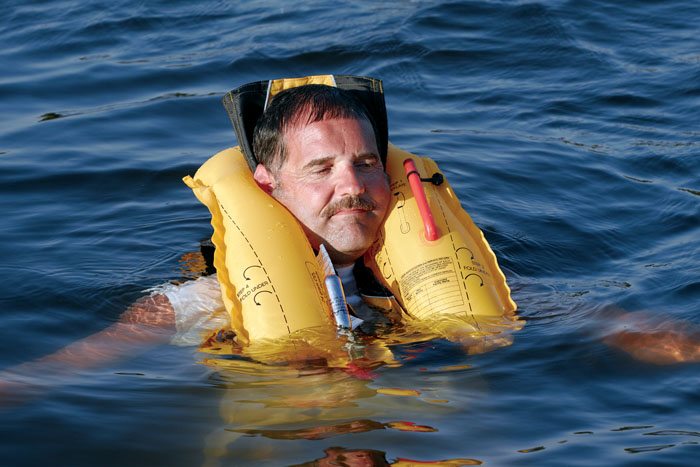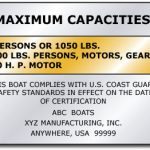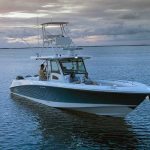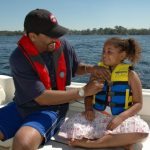Always look for the Coast Guard approval number on any PFD you purchase.
Try on your PFD to see if it fits comfortably snug. Then test it in shallow water to see how it handles. To check the buoyancy of your PFD in the water, relax your body and let your head tilt back. Your PFD should keep your chin above water, and you should be able to breathe easily.
PFD’s on athletic builds will rarely “ride up” when in the water. But if your mid-section is bigger than your chest, you may find that your PFD tends to float up under your chin. If this is the case, make sure this condition does not compromise the performance of the PFD, and if it does, look for a model or size that does not.
Be aware that your PFD may not act the same in swift or rough water as it does in calm water.
Never alter your PFD. If yours doesn’t fit, get one that does.
Don’t put heavy objects on your PFD or use it for a kneeling pad or boat fender. PFD’s lose buoyancy when crushed.
Assign life jackets to each passenger, and make sure they fit, the straps are secure and adjusted properly, and are readily accessible to that person should the need arise. Do this BEFORE you depart. It’s too late when you’re in the water.
Coast Guard approved inflatible PFD’s are only approved for use by those over 16 years of age, and are not recommended for non-swimmers. They are not approved for PWC operation, either.
Having CG approved PFD’s aboard for each passenger isn’t enough. They should be the right size for those passengers, and must be “readily accessible”. That means they should be within easy reach of you and your passengers so they can be donned in a hurry should an emergency arise. We’ve seen too many life jackets still sealed in plastic, tucked nicely out of site in some obscure compartment or locker. Get them out in the open and within reach!
Check your PFD’s frequently for grease or rot. Pull on the straps with force, and if the strap tears off or pulls a seam, consider yourself lucky that it did it in your hands rather than on the torso of your son or daughter. Check your PFD for rips, tears or holes, mildew, shrinkage, or waterlogging.
Now there’s a law that requires that anyone aboard your boat who is age 13 or under must be WEARING a properly-fitted, CG approved PFD. This applies to all Federal waterways, and several states are introducing or have passed legislation to implement a similar regulation for non-Federal waterways. There’s no excuse for not having life jackets on small children when boating. They can’t make those decisions for themselves, and depend on you for their safety. Little kids can be over the side in a heart beat, so fit them out with a PFD, and remind them that the Coast Guard guys wouldn’t THINK of going out on the water without them on. They’ll think that’s cool.
Teach your children how to relax their arms and legs in the water, so that if they fall in, the PFD will keep them afloat in a “face up” position. If a child panics when they take a sudden fall into the water, they’ll thrash around. In those cases, a PFD may not keep them face up.
When retrieving someone from the water, tie a length of polypropylene line to your type IV throwable PFD. For one thing, someone in the water who is a little stressed anyway will feel more confident knowing you’re at the end of a line with him or her at the other end. Secondly, if you throw it to someone and MISS, you can quickly retrieve the device and try again.
Choose life jackets with bright colors, preferably orange or red. If your child wants a black one with Barney on it and promises to wear it, that’s still better than having none. But if you boat in conditions where someone may need to see you in the water, you’ll want to be as visible as possible.
PFD’s that are labelled as “type V” must be worn to be counted toward the minimum PFD on board requirements.
Some state require that PFD’s be worn while aboard the vessel, and those laws are usually age-specific. Be sure and check with YOUR local agencies to make sure you’re operating your boat within those regulations.








